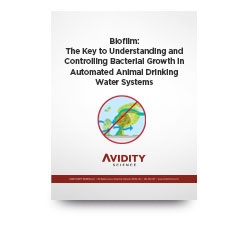We use cookies to make your experience better. To comply with the new e-Privacy directive, we need to ask for your consent to set the cookies Learn more.
 Untreated water sources invariably develop biofilm secreted by microbes. These potentially pathogenic microorganisms, such as bacteria, present real threats to both research animals and research itself. Unlike inorganic particulate matter in water that can be strained and removed using finer and finer levels of filtration, microorganisms defy complete elimination. The key to demystifying this phenomenon is in understanding some basics of their biology.
Untreated water sources invariably develop biofilm secreted by microbes. These potentially pathogenic microorganisms, such as bacteria, present real threats to both research animals and research itself. Unlike inorganic particulate matter in water that can be strained and removed using finer and finer levels of filtration, microorganisms defy complete elimination. The key to demystifying this phenomenon is in understanding some basics of their biology.
In favorable conditions, a single microorganism can double in size and reproduce by dividing into two every 20 minutes or so through a process called binary fission. Unchecked, the thriving organisms can continue this reproductive cycle at an alarming rate. A single bacteria could feasibly proliferate to 6,000,000 kindred within a 24-hour period. Each in turn secretes a slimy, sticky substance called glycocalyx - the familiar, extracellular biofilm which serves to trap nutrients within their biome and help them adhere to surfaces. At the point which biofilm can be seen by the unaided eye, there is an established and flourishing bacterial community residing in animal drinking water. But although methods to completely nullify the propagation cycle elude us, there are proven methods to keep it under control.

One method to curb biofilm growth is to minimize the nutrient availability in water. Applying a system of filtration such as particle filters, an ultrafilter and reverse osmosis system reduces nutrient availability vital for microorganisms to grow and reproduce. Additionally, the turbulence caused by periodic flushing of automated watering systems and components aids in loosening and expelling biofilm using high velocity water to scrub the system. Further, employing chemical agents like chlorine is an additional means of controlling biofilm growth. Using a controlled dose of chlorine as prescribed by the sanitizing equipment manufacturer is known to be an effective way to kill bacteria and suspend biofilm growth.
In the absence of a sound strategy for the total removal of biofilm generating microorganisms in animal drinking water, there is solace in knowing that colonizing microbes can be restrained if deliberate control methods like those mentioned above are applied. For a more comprehensive look at biofilm as it relates to animal drinking water, please read our white paper 'Biofilm: The Key to Understanding and Controlling Bacterial Growth in Automated Animal Drinking Water Systems' below, or contact Avidity Science for additional information.
 |
|
Biofilm: The Key to Understanding |